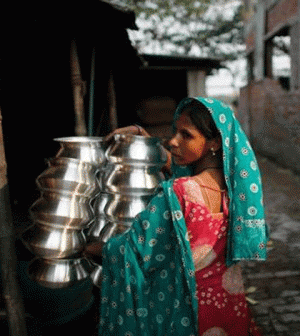- Finding Unshakable Power in a World That Wants to Pull Us ApartPosted 5 months ago
- What could a Donald Trump presidency mean for abortion rights?Posted 5 months ago
- Financial Empowerment: The Game-Changer for Women in Relationships and BeyondPosted 6 months ago
- Mental Health and Wellbeing Tips During and After PregnancyPosted 6 months ago
- Fall Renewal: Step outside your Comfort Zone & Experience Vibrant ChangePosted 6 months ago
- Women Entrepreneurs Need Support SystemsPosted 6 months ago
How can climate change measures work if women aren’t included?

Written by Tasfia Tasnim
A woman carries aluminium pots as she works in a factory by the river Buriganga in Dhaka May 20, 2014. REUTERS/Andrew Biraj
Climate policy is not about technologies; rather it’s about people. If climate change policy is about ensuring a sustainable future by combining development and environmental issues, it must take into account the interests of all involved: both women and men.
Both have the right to be involved in decision-making on climate policy, whether at the city or community level. Climate policy will only be effective if people, their gender roles and traditional tasks in society are taken into account.
If social and gender issues are fully incorporated into climate policy, it can help ensure resources are available for everyone. To build inclusive urban climate change resilience, cities should make commitments to climate policy and to gender equity, then link those two commitments.
Climate change adds to women’s daily challenges in developing and less-developed countries in Asia, as in other regions. Mainly in the urban slums of Asia, poor women have limited access to resources, restricted rights, limited mobility and limited voices, and in community and household decision-making those realities can make them much more vulnerable than men to the effects of climate change.
Persistent gender inequalities not only undermine the well‐being of women themselves, but also limit their ability to improve the conditions of their families, households and communities. Constraints affecting women’s incomes, resources and power, due to gender inequality, exacerbate the effects of climate change and hamper the effectiveness of their responses to climate change.
So, a gender-sensitive approach is needed, taking into account the position women find themselves in, to build urban climate change resilience.
Urban areas need to address the unequal power relations and the lack of representation and participation of women. Women, after all, work in the household and have more idea about the consumption of energy while doing household chores. Many women who work outside the home use public transportation to get there, which can hold down emissions of climate-changing greenhouse gases.
So, while women are not aware of it, they actually help in curbing climate change. Climate policy interventions which incorporate mitigation, low carbon development and adaptation are very broad undertakings, and cover almost all sectors – and women are involved in all of them.
Low emission energy investments should be established that are gender‐responsive, contributing to increasing both men and women’s access to modern and clean forms of energy for lighting, cooking, heating and cooling, pumping, transportation, communication and other more.
For example, in urban slums, “eco-friendly” stoves – which use less fuel and produce less smoke – could be shared by three or four households. NGOs or research institutes could raise women’s awareness about poor water quality and organise communities – engaging women in particular – to plan, manage and operate water kiosks as a community enterprise.
Waste management, by collecting organic waste and producing compost, could be another low-carbon option. And more entrepreneurial opportunities and new markets for private investors, particularly small enterprises owned by women, could be created.
Better access to energy contributes to building climate resilience, as women can use electricity to run businesses and earn money, through things like food processing and preservation, sewing, and craft production.
Girls and women also should be trained in areas such as personal and public health, fire safety, counseling and disaster planning, and should get better access to information. Government and planners should aim to reduce a city’s carbon footprint by creating well‐lit public transport stations, to help women access public transport safely.
Local governments should work closely with citizens and involve them in their efforts to address climate change by developing more options for empowering women so that they can play their role during climate risks.
(Tasfia Tasnim is an intern at the International Center for Climate Change and Development based in Dhaka, Bangladesh. Her blog was one of four finalists in the 2016 Asian Cities Climate Change Resilience Network (ACCCRN) blog competition.)






